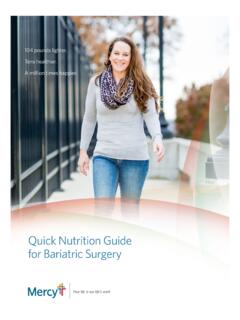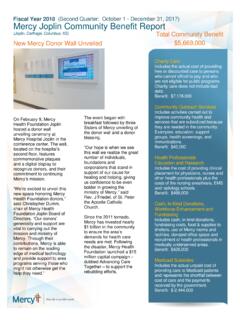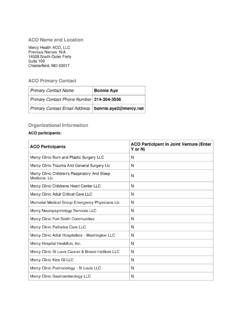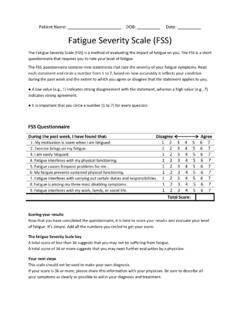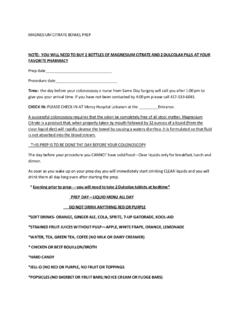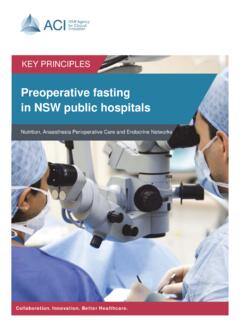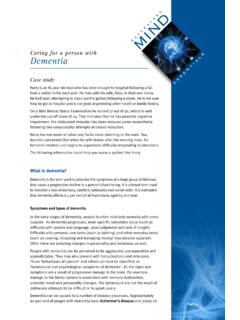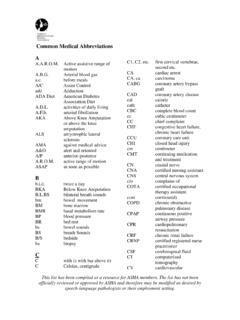Transcription of Instructions for Post-Operative Care Following Hysterectomy/
1 STL_29228 (12/20/13) Road to Recovery Instructions for Post-Operative care Following hysterectomy / Abdominal SurgeryNick Chobanian, MDDirector, Gynecologic OncologyDavid C. Pratt Cancer Center607 S. New Ballas Rd. | Suite 2350St. Louis, MO 631411 | Road to Recovery: Post-Operative CareRoad to Recovery: Post-Operative care | 6 Notes:Questions for My Doctor:Your surgery is over, and now you are on the road to recovery. From the moment you arrive in your room after surgery, you are preparing to be discharged from the hospital. You may return home or to a convalescent facility. Your doctor, the resident physicians and nurses will work with you to make certain that your recovery is on schedule.
2 Goals have been set for you to achieve each day that you are in the hospital. Your cooperation in making progress toward these goals will help ensure a smooth recovery. Prior to discharge, there are several important steps for you to take that will help you reach your recovery goals. You must be able to: eat and drink without difficulty, be free of nausea and vomiting, be able to ambulate in the hall, have return of bowel and bladder function, be without fever and any pain should be well controlled with oral medication. This booklet has been prepared to assist you in making the transition from hospital to to Recovery: Post-Operative care | 25 | Road to Recovery: Post-Operative CareDaily Medications You may resume taking home medications, as directed by your Follow-UpYou will be given an appointment for a Post-Operative exam about four weeks after your surgery.
3 Call the office, in the meantime, with any problems or questions that you may to Call the Doctor Increase in pain; difficulty managing pain Development of a fever or greater Bright red bleeding from the vagina or incision Redness, warmth or purulent drainage from the incision Difficulty urinating Unable to have a bowel movement Nausea or vomiting Pain, redness or warmth in calves of legs Sudden shortness of breath or chest painOffice number: 314 251-4260 Doctors Exchange: 314 364-5421 (for after regular office hours, weekends, holidays)Relax, recover; be kind to yourself and let others be good to you as you make your way down the Road to Recovery. Post-Operative Appointment:Date: _____Time: _____David C.
4 Pratt Cancer Center607 S. New Ballas Rd. | Suite 2350St. Louis, MO 63141 Taking care of YouActivity Initial recovery from major surgery will take approximately six weeks; however, the return of your pre-surgery energy level can take several months. You may notice that you tire more easily during normal activities. It is recommended that you discuss the date of your return to work with the doctor at your Post-Operative activities gradually. Even though you may begin to feel like your old self in a couple of weeks, you are cautioned against trying to speed your recovery along. If you attempt to return to normal activities too quickly, this may result in a setback of increased pain or vaginal bleeding ( Following hysterectomy ).
5 During the first week home from the hospital, continue to ambulate, taking short walks. Remember, inactivity increases your risks of post - operative complications. Continue to use your incentive spitometer at home for several days. While you are taking narcotic pain relievers, you may feel the need to nap occasionally. It is best not to become overtired. Allow family and friends to perform routine chores such as cooking, laundry and cleaning. You may begin to do light housework the second week you are home. You may ride in a car for short distances, but driving should be avoided for approximately two weeks. If you must take a longer ride, be certain to make frequent stops, getting out of the car and to Recovery: Post-Operative care | 43 | Road to Recovery: Post-Operative CareYou should not drive until you have stopped taking narcotic pain medication, except for those taken at bedtime.
6 You must be sufficiently free of pain to be able to react quickly, using the steering wheel and brake in an emergency, while being able to wear your safety restraint comfortably. Limit stair climbing the first two weeks at home. Plan your daily activities so that your trips up and down stairs will be at a minimum. Avoid all heavy lifting. Lift nothing heavier than a jug of milk. Sexual intercourse should not be resumed until after your post - operative appointment. At that time, the doctor will examine the vaginal cuff, the upper portion of the vagina that was sutured closed, to determine the degree of healing that has taken place. It is not unusual to have some vaginal discharge during the first couple of weeks after surgery.
7 Avoid douching or use of ControlUpon discharge from the hospital, you will be given prescriptions for an oral narcotic pain reliever and a non-steroidal anti-inflammatory. You are encouraged to take both medications while you are still having pain. The narcotic, Percocet or (oxycodone/APAP), is prescribed most often to relieve incisional pain. Follow label directions taking one or two tablets every four to six hours as needed for pain. The non-steroidal anti-inflammatory, Ibuprofen, may be taken every six to eight hours with food. Taking it on an empty stomach may cause an upset stomach. Ibuprofen helps relieve muscle soreness and generalized aching. It is best to alternate the use of these two drugs.
8 First take the Percocet, followed two hours later with the Ibuprofen. This helps achieve continuous pain relief. Keep a record of administration times to make certain the medications are taken as the return to normal eating patterns gradually. It is best to eat several (6) small meals throughout the day, rather than the usual three square meals a day. It takes a number of days for normal peristalsis (movement of food in the intestine) to return Following surgery. Attempting to eat large meals will increase the likelihood of developing uncomfortable gas in the colon, which can lead to nausea and vomiting. Increase fiber in your diet by eating fresh fruits and vegetables and whole grains.
9 EliminationIt is not unusual for there to be some hesitation on urination and even slight burning Following removal of the Foley (indwelling) catheter that was placed during your surgery. These sensations should subside in a few days as you urinate more often. Listening to the sound of running water or pouring warm water over the vulva may help start the urine flow. It is helpful to drink 6-8 glasses of water each. Cranberry juice and other fruit juices are also bowels have become sluggish Following surgery due to the effects of anesthesia, manipulation during the procedure and from narcotic pain relievers. Continue to take stool softeners (Colace or generic equivalent) once in the morning and each evening to help make the passage of stool more comfortable.
10 If abdominal bloating and gas causes discomfort, you may take simethicone tablets, as directed on the package. Products such as Gas X tablets may be helpful. Walking helps relieve gas. If your bowels have not moved normally between three and five days Following your surgery, you may need to take a laxative. Milk of Magnesia, one-two teaspoonfuls every 8 hours should produce a comfortable, normal bowel movement in 24 hours. Products like Senokot-S that combine a stool softener and a natural vegetable laxative can also be taken. Sometimes senna products may cause intestinal cramping. Ducolax suppositories may also be of Your Incision/HygieneIn most cases, sutures will be placed under the skin, instead of staples on top of the skin.
